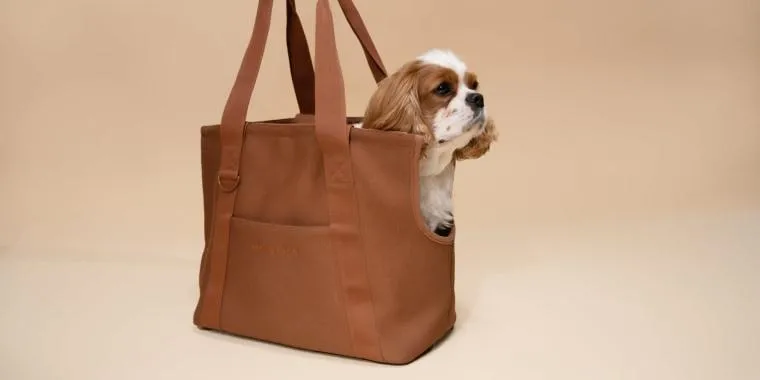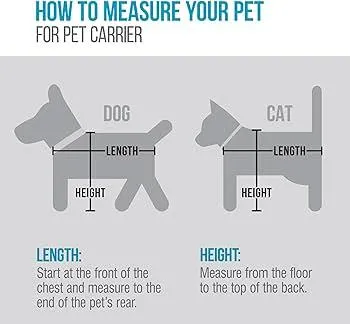Everything You Need to Know About Airline Dog Carrier Sizes
Whether you’re taking your furry friend on vacation or moving to a new home, traveling by air with your dog can be a logistical challenge. One of the key things to understand is the size restrictions for your dog’s carrier. In this article, I’ll cover the carrier size requirements of major airlines, tips for finding the right sized carrier, and other considerations to make your dog’s flying experience as stress-free as possible.
Standard Airline Dog Carrier Size Limits
Most domestic airlines in the U.S. adhere to the size limits set by the United States Department of Transportation (DOT). Under DOT guidelines, a dog carrier cannot exceed 18 inches in length by 14 inches in width by 9 inches in height. However, it’s important to double check the specific size policies of your airline, as some carriers have slightly smaller restrictions.
From my experience traveling with dogs, the most stringent size limits tend to belong to larger airlines like American, Delta, and United. These airlines generally cap carrier dimensions at 17 by 13 by 8 inches. Meanwhile, smaller regional carriers sometimes allow carriers up to the full 18 by 14 by 9 size. International carriers also vary in their restrictions, so research the rules for your specific flight itinerary.
How to Find the Right Sized Airline Dog Carrier
When shopping for a carrier, the key is to get one that’s just big enough without being too roomy. An overly large carrier is more likely to be rejected at the gate. Here are some tips:

- Know your dog’s measurements. Take them while your pup is standing normally, without being stressed. This will help narrow down the right carrier size.
- Check multiple carrier brands. Sizes can vary between manufacturers, so trying different options is wise. Read reviews to see what fits other dogs of similar builds.
- Leave room for growth if your dog is still young. It’s better to have a carrier they can grow into than one that’s too tight from the start.
I’ve faced situations where carriers didn’t meet airline limits despite fitting my dog comfortably at home. So always err on the smaller side and bring extra padding or blankets if needed for comfort instead of size alone.
Other Considerations When Flying With Dogs
In addition to carrier size, here are some other factors that can impact your dog’s flying experience:
- Training and socialization. The more accustomed your pup is to new people, places and noises, the less stressful air travel will be.
- Proper ID tags. Make sure their carrier is labeled inside and out with current contact info in case you get separated.
- Comfort items. Toys, blankets or treats can help ease anxiety. But choose soft items to avoid injury if the carrier gets tossed.
- Tranquilizers. Talk to your vet about possible medications to keep your dog calm on the flight if they get nervous easily.
- Airline policies. Know things like health cert requirements, in-cabin vs cargo limits and seasonal prohibition times.
Basically, preparation is key when flying with pets. Being aware of carrier size and familiarizing your four-legged friend with air travel processes as much as possible will make the whole experience less stressful for both of you.
A Personal Example Flying Cross-Country With My Dog
I’ll never forget the time I moved across the entire country with my Miniature Schnauzer, Buddy. We had to make the long haul in economy seats over multiple flights from LA to NYC. Finding the perfect sized carrier that would fit under the seat was tricky. After trying what seemed like every carrier model, we ended up going with an ultra-slim soft-sided bag from Sherpa that was just like 17 inches long.

Buddy wasn’t thrilled about being cooped up for so long, so to keep him calm I brought several of his favorite toys and snacks. I also gave him a light anxiety medication my vet prescribed. Amazingly, he slept almost the entire journey! We hit some turbulence at one point over Kansas and I’ll never forget the death grip my little buddy had on my hand sticking out of his bag. But he was a total champ otherwise.
By planning ahead and being prepared, our big cross-country move with air travel went smoothly despite it being Buddy’s first major flying experience. Understanding airline size rules was key, and I’m glad we found the perfect carrier to meet the requirements. I’ve since recommended the Sherpa brand to other pet owners I know who travel by plane.
Wrapping It All Up
As you can see, getting the right sized airline-compliant dog carrier plays an important role in making flying with pets less stressful. But preparation, training and making sure your dog is accustomed to the travel environment are also huge factors. Hopefully this guide answered your questions about size limits on major airlines and tips for finding the suitable carrier. Safe travels to you and your furry companion!
Airline Approved Dog Carrier Sizes
| Carrier Size | Weight Limit | Dimensions | Airline Rules |
|---|---|---|---|
| Small | up to 20 lbs | Up to 16″L x 11″W x 11″H | Most airlines allow under-seat |
| Medium | 21-50 lbs | Up to 18″L x 13″W x 13″H | Many airlines allow under-seat or in cabin with owner |
| Large | 51-70 lbs | Up to 24″L x 17″W x 13″H | Most require in cargo hold |
| Extra Large | Over 70 lbs | Varies by airline | Always placed in cargo hold |
| Soft-Sided | Varies | More flexible sizing | Some airlines do not allow soft-sided carriers |
FAQ
-
What is the maximum size dog carrier allowed on airlines?
Most planes only permit dog carriers that fit under the seat in front of you. This usually means the carrier cannot be over around 18 inches tall by 10-12 inches deep. Larger sizes will need to be checked as baggage.

-
Can I bring two dogs on the plane if they are in carriers?
Normally airlines only allow one pet container per passenger whether it holds one or two small dogs. However, some carriers make a double dog carrier that fits as a single item. You’d need to check with your specific airline if this kind of two-in-one carrier is okay.
-
What sizes of dog carriers are suitable as carry-on?
Typically, dog carriers under 18x13x9 inches can serve as a carry-on bag. But it relies on the individual plane too. Maybe call the airline and confirm before showing up with your pup?
-
Do soft-sided carriers or hard plastic ones work best?
Both soft and hard carriers can work, but hard plastic has certain benefits. It may provide better protection from bumps and protect other passengers if your dog gets nervous. However, some dogs feel more comfortable in cozy soft sides. Do what’s best for your pup!
-
What should I consider when choosing a size?
Consider not only your dog’s dimensions but also allow room for them to stand up, turn around, and feel cozy. Maybe get one a bit bigger than the exact size rather than too small? Also will the carrier fit overhead storage or under the seat as required by the airline?

-
Are there any size restrictions when checking a dog carrier?
When checked as luggage, carriers are sometimes limited to no more than 100 linear inches – around 28x21x17 inches. Airlines may assess charges for oversized items too. It is recommended to check carrier dimensions allowed as baggage with your airline of travel beforehand.
-
What are some recommended carrier sizes for small dog breeds?
Numerous studies and canine experts suggest 12x9x9 inches or smaller carriers work well for toy breeds like Chihuahuas or Yorkies. For mini and small breeds like Pugs or Shih Tzus, 14x10x10 inches could basically be a good fit. Always measure your pooch though before committing to a size.
